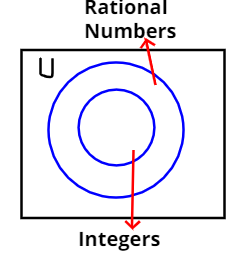
State whether the following statement is true or false. Justify your answer.
The set of all integers is contained in the set of all rational numbers.
\[{\text{(A)}}\]True
\[{\text{(B)}}\]False
Answer
610.8k+ views
Hint:- Use Venn’s Diagram.

As we know that,
A rational number is of the form \[\dfrac{p}{q}\] where q is not equal to zero.
So, some rational numbers will be \[\dfrac{{ - 5}}{3},\dfrac{2}{5},\dfrac{1}{7},\dfrac{5}{1},\dfrac{{ - 3}}{1}\]etc.
And, integer is a whole number (not a fractional number) that can be positive, negative, or zero.
As if we take, \[q = 1\] then every rational number will become integer.
And we know any set X is contained in any other set Y if all elements of X also belong to Y.
So, every integer number is written as a rational number with q=1.
Hence, the statement is true. The set of all integers is contained in the set of all rational numbers.
Note:- Whenever we came up with this type of problem then we should go with the
definition of rational numbers, integers, whole numbers and non-rational numbers.
It will be the easiest and efficient way to prove the result.

As we know that,
A rational number is of the form \[\dfrac{p}{q}\] where q is not equal to zero.
So, some rational numbers will be \[\dfrac{{ - 5}}{3},\dfrac{2}{5},\dfrac{1}{7},\dfrac{5}{1},\dfrac{{ - 3}}{1}\]etc.
And, integer is a whole number (not a fractional number) that can be positive, negative, or zero.
As if we take, \[q = 1\] then every rational number will become integer.
And we know any set X is contained in any other set Y if all elements of X also belong to Y.
So, every integer number is written as a rational number with q=1.
Hence, the statement is true. The set of all integers is contained in the set of all rational numbers.
Note:- Whenever we came up with this type of problem then we should go with the
definition of rational numbers, integers, whole numbers and non-rational numbers.
It will be the easiest and efficient way to prove the result.
Recently Updated Pages
Why are manures considered better than fertilizers class 11 biology CBSE

Find the coordinates of the midpoint of the line segment class 11 maths CBSE

Distinguish between static friction limiting friction class 11 physics CBSE

The Chairman of the constituent Assembly was A Jawaharlal class 11 social science CBSE

The first National Commission on Labour NCL submitted class 11 social science CBSE

Number of all subshell of n + l 7 is A 4 B 5 C 6 D class 11 chemistry CBSE

Trending doubts
What is meant by exothermic and endothermic reactions class 11 chemistry CBSE

10 examples of friction in our daily life

One Metric ton is equal to kg A 10000 B 1000 C 100 class 11 physics CBSE

1 Quintal is equal to a 110 kg b 10 kg c 100kg d 1000 class 11 physics CBSE

Difference Between Prokaryotic Cells and Eukaryotic Cells

What are Quantum numbers Explain the quantum number class 11 chemistry CBSE




